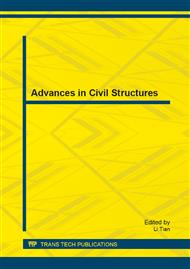p.775
p.782
p.786
p.790
p.798
p.803
p.808
p.812
p.818
Structural Design of Yunnan Ruili Spa Resort Sightseeing Tower
Abstract:
Yunnan Ruili spa resort sightseeing tower is a high-rise hybrid structure building, which is 52.8 meters in height. In the design process, for the purpose of ensuring the correctness and reliability of the model analysis and design, general finite element analysis software SATWE and ETABS are used for flexible modeling and analysis. Through controlling and adjusting related parameters, the reasonable calculation results are obtained, which can be regarded as the basis of the design. In this paper, relevant problems are also discussed for the foundation design and superstructure design of the tower.
Info:
Periodical:
Pages:
798-802
Citation:
Online since:
August 2013
Authors:
Keywords:
Price:
Сopyright:
© 2013 Trans Tech Publications Ltd. All Rights Reserved
Share:
Citation:


